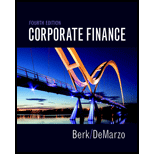
Corporate Finance Plus MyLab Finance with Pearson eText -- Access Card Package (4th Edition) (Berk, DeMarzo & Harford, The Corporate Finance Series)
4th Edition
ISBN: 9780134408897
Author: Jonathan Berk, Peter DeMarzo
Publisher: PEARSON
expand_more
expand_more
format_list_bulleted
Question
Chapter 19, Problem 8P
Summary Introduction
To determine: The
Introduction:
Free cash flow indicates the amount of cash a firm has after spending on all capital expenditures. Free cash flow to equity indicates the amount available to the equity shareholders of a company after all the expenses.
Expert Solution & Answer
Want to see the full answer?
Check out a sample textbook solution
Students have asked these similar questions
critically discuss the hockey stick model of a start-up financing. In your response, explain the model and discibe its three main stages, highlighting the key characteristics of each stage in terms of growth, risk, and funding expectations.
Solve this problem please .
Solve this finance question.
Chapter 19 Solutions
Corporate Finance Plus MyLab Finance with Pearson eText -- Access Card Package (4th Edition) (Berk, DeMarzo & Harford, The Corporate Finance Series)
Ch. 19.1 - Prob. 1CCCh. 19.1 - Prob. 2CCCh. 19.2 - Prob. 1CCCh. 19.2 - Prob. 2CCCh. 19.3 - What is a pro forma income statement?Ch. 19.3 - Prob. 2CCCh. 19.4 - Prob. 1CCCh. 19.4 - Prob. 2CCCh. 19.5 - Prob. 1CCCh. 19.5 - Prob. 2CC
Ch. 19.6 - Prob. 1CCCh. 19.6 - Prob. 2CCCh. 19 - Prob. 1PCh. 19 - Prob. 2PCh. 19 - Prob. 3PCh. 19 - Prob. 4PCh. 19 - Under the assumptions that Idekos market share...Ch. 19 - Prob. 6PCh. 19 - Prob. 7PCh. 19 - Prob. 8PCh. 19 - Prob. 11PCh. 19 - Calculate Idekos unlevered cost of capital when...Ch. 19 - Using the information produced in the income...Ch. 19 - How does the assumption on future improvements in...Ch. 19 - Approximately what expected future long-run growth...Ch. 19 - Prob. 16P
Knowledge Booster
Similar questions
- solve this question.Pat and Chris have identical interest-bearing bank accounts that pay them $15 interest per year. Pat leaves the $15 in the account each year, while Chris takes the $15 home to a jar and never spends any of it. After five years, who has more money?arrow_forwardWhat is corporate finance? explain all thingsarrow_forwardSolve this finance problem.arrow_forward
arrow_back_ios
SEE MORE QUESTIONS
arrow_forward_ios
Recommended textbooks for you

 Intermediate Financial Management (MindTap Course...FinanceISBN:9781337395083Author:Eugene F. Brigham, Phillip R. DavesPublisher:Cengage Learning
Intermediate Financial Management (MindTap Course...FinanceISBN:9781337395083Author:Eugene F. Brigham, Phillip R. DavesPublisher:Cengage Learning Survey of Accounting (Accounting I)AccountingISBN:9781305961883Author:Carl WarrenPublisher:Cengage Learning
Survey of Accounting (Accounting I)AccountingISBN:9781305961883Author:Carl WarrenPublisher:Cengage Learning- Principles of Accounting Volume 2AccountingISBN:9781947172609Author:OpenStaxPublisher:OpenStax College


Intermediate Financial Management (MindTap Course...
Finance
ISBN:9781337395083
Author:Eugene F. Brigham, Phillip R. Daves
Publisher:Cengage Learning

Survey of Accounting (Accounting I)
Accounting
ISBN:9781305961883
Author:Carl Warren
Publisher:Cengage Learning

Principles of Accounting Volume 2
Accounting
ISBN:9781947172609
Author:OpenStax
Publisher:OpenStax College